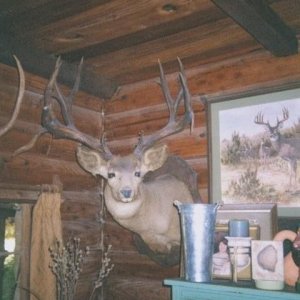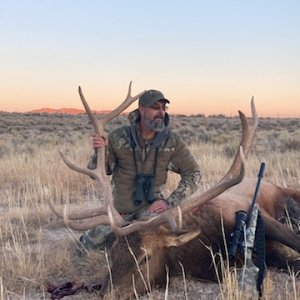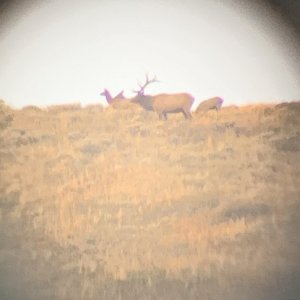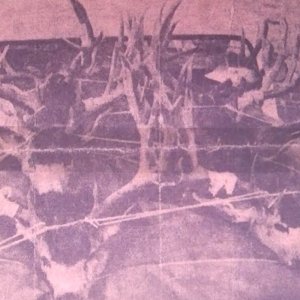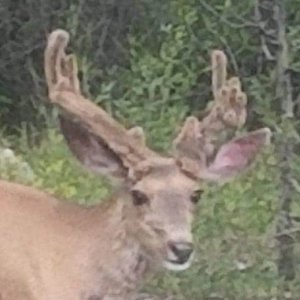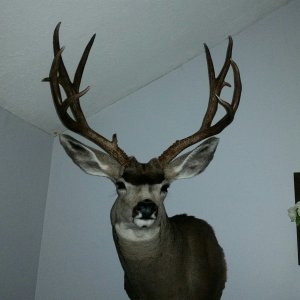Here is a North American Mule/Blacktail Deer Conservation Plan that was put together by 13 western states, 4 Midwest states, and 2 southern states Wildlife Agencies along with 4 Canadian agencies that formed ?The Mule Deer Working Group? sponsored by the Western Association of Fish and Wildlife Agencies. The group has identified the issues important to mule deer management under several topics. The Group summarized these issues in the book ?Mule Deer Conservation: Issues and Management Strategies? in 2003.
North American Mule Deer Conservation Plan
To address the multitude of issues impacting recovery of mule deer populations, the Western
Association of Fish and Wildlife Agencies (WAFWA) chartered the Mule Deer Working Group (MDWG), herein referred to as ?Group.? This group, comprised of representatives of all agencies that are members of WAFWA, was established to address 3 specific tasks including:
1. Develop solutions to common mule deer management problems.
2. Identify and prioritize cooperative research and management activities in the western states and provinces.
3. Increase communications between agencies and the public that are interested in mule deer, and between those in agencies, universities, and nongovernmental organizations that are interested in mule deer management.
Increased communication among agency biologists will allow managers to face new resource challenges with the best available science. This eco-regional and West-wide approach to mule deer conservation will allow natural resource administrators to make science- based decisions and provide up-to-date and accurate information to their stakeholders.
At the first Group meeting, members identified the issues that we considered important to mule deer management. These topics included short and long-term changes to habitat, differences in mule deer ecology between eco-regions, changes to nutritional resources, effects of different hunting strategies, competition with elk, inconsistent collection and analyses of data, deer-predator relationships, disease impacts, and interactions that occur with weather patterns and these issues. The Group summarized these issues in a book entitled Mule Deer Conservation: Issues and Management Strategies in 2003.
There are a multitude of factors that continue to adversely impact mule deer populations including habitat loss to development, deterioration of forage quality and quantity, droughts, severe winter weather, competition with other ungulates, predation, disease, poaching, and increased hunting mortality. The Group concurs that ultimately the key to managing mule deer in the foreseeable future lies in maintaining high quality habitat. The Group maintains that this can be best accomplished by managing mule deer using the eco-regional approach we promote in this plan.
Eco-regional Corrdination:
Objectives and Strategies
1. Improve and maintain intergovernmental coordination between states/provinces, tribal, federal agencies, and private entities.
a. Conduct annual coordination meetings between state/province agencies, and federal, tribal and private land management authorities at the local, state, regional, and national level.
b. Devote a round table coordination/assessment session at the Deer/Elk Workshop for all wildlife and land management agencies to discuss current mule deer management activities and research needs.
c. Assist tribal wildlife agencies with collection of survey and harvest data to maintain consistency.
d. Provide consultation and input commensurate with the plan goals and objectives into planning activities sponsored by other land and/or wildlife management entities.
e. Implement collaborative planning measures for all natural resource management entities.
f. Ensure the Group meets at least annually to continue to address our 3 objectives as assigned by WAFWA.
2. Develop and adopt standardized survey methodologies, population models, and harvest data collection processes that are based on scientifically- sound standards and assumptions.
a. Maintain separate survey and harvest data for white-tailed deer and mule deer.
b. Coordinate proposed research and management activities among states/provinces within eco-regions.
3. Share appropriate survey methodologies, population models, and harvest data collection processes that are based upon standards and assumptions supported by the best available science.
a. At least annually, each Agency/Department will present a brief update to the Group on survey methodologies, population models, processes, and data acquisition approaches with emphasis on what is working and what is not. Written summaries should be prepared and distributed to the Group.
b. At each Deer and Elk Workshop there will be at least one session devoted to survey methodologies, population models, processes, and data acquisition approaches for mule deer management.
c. The Program Chair of the Deer/Elk Workshop will maintain consistent status report formats by using the report format developed and implemented by the Group.
4. Conduct gap analyses on information needs for mule deer populations and their habitats that can be applied on an eco-region or range-wide basis.
a. The Group, working closely with mule deer researchers, will identify and prioritize research studies that could be designed, analyzed and presented on an eco-region or range-wide perspective.
Habitat:
Society wants wildlife populations managed at sustainable, optimum levels for their inherent aesthetic values, recreation, sport harvest, and scientific purposes. It is thought by many wildlife managers that wildlife abundance is ultimately limited by quality and availability of habitat. But, it is often difficult to convince wildlife enthusiasts that human impacts render sustaining wildlife populations, including mule deer, at desired levels difficult and sometimes impossible,
because habitat has been eliminated or otherwise negatively altered.
Direct human impacts to mule deer habitat (quality and availability) include: oil, gas, and mineral exploration and extraction; urban growth; highway, railroad, and fenceline development and other impediments to migration. Indirect factors related to human population growth include recreation activities such as dispersed camping and off-highway vehicle use. Vegetative communities important to mule deer are altered by land management practices including fire suppression, livestock grazing, shrub eradication, and disturbances promoting cheatgrass and other exotic plant invasions.
Goal: Mule deer habitat potential is optimized for quality and quantity across mule deer range.
Objectives and Strategies
1. Identify threats to mule deer habitat throughout their range.
a. Digitally map mule deer distribution throughout the West.
b. Attribute all mapped polygons with limiting factors as established by the Group.
c. Develop a searchable database that underpins the mapping effort.
d. This system will be used to prioritize areas where mule deer habitat restorations are planned.
2. Restore or improve mule deer habitat function throughout mule deer range.
a. Proactively manage shrub communities (using prescribed fire, mechanical treatment, or other approaches as appropriate at a site specific basis) to maintain mosaics of uneven aged stands to enhance habitat conditions for mule deer.
b. Ensure that security cover requirements for mule deer are incorporated in all restoration plans developed to improve mule deer habitat.
c. Develop and implement habitat restoration protocols that are useful in restoring ecological function in mule deer habitat. This will be most useful if developed at the eco-regional level as identified in this plan.
d. Foster habitat protection programs including purchasing or implementing conservation easements or other methods to provide for long-term protection and management of mule deer habitat.
e. Manage mule deer habitat in a fashion to control type conversions (i. e., conversion of rangeland to croplands, and shrublands to monotypic pinyon-juniper stands).
f. Allow normal fire regimes to occur where this practice does not pose high risk to human developments.
g. Develop and implement habitat treatment protocols that reduce the impacts of cheatgrass or other invasive plants.
h. Ensure that water distribution is maintained in areas where freestanding water is documented to be important to mule deer.
i. Encourage land management practices that promote mast producing and browse species vegetation to improve nutritional requirements for mule deer.
3. Limit development impacts to important mule deer habitats.
a. Coordinate with local municipalities or other agencies to discourage development of areas important to mule deer.
b. Actively participate in all levels of public land management planning activities.
c. Review all land management plans to ensure the impacts of extractive activities including highway developments or oil and gas exploration are minimized to the extent possible.
d. Review all transportation corridor development plans and ensure that methods are incorporated to minimize direct mortality via vehicle-deer collisions and to ensure the roadway is permeable to mule deer.
4. Limit human related impacts to important mule deer habitats through recreation or other non-development human impacts.
a. Manage high levels of human recreation to avoid negative impacts on key mule deer habitat features.
b. Evaluate road densities and ensure that road densities are not adversely impacting mule deer habitat, particularly during times when fawns are being born and reared.
c. Evaluate all land management plans to ensure impacts of livestock grazing are not detrimental to mule deer habitat, particularly in locations and seasons that are highly important to mule deer.
d. Evaluate timber management strategies to ensure mule deer habitat quality is maintained or enhanced, or that post-removal restoration is conducted to improve mule deer habitat.
Nutrition:
Nutrition has a fundamental role in virtually every life process of mule deer. Nutrition influences ovulation, conception, gestation, lactation, survival, and home range, both seasonally and annually. Nutritional status of individuals in a population subsequently influences additional factors, such as susceptibility to predation, ability to compete for needed resources, resistance to diseases, and ability to survive severe weather conditions that may last for extended periods. In turn, many factors influence nutrition of free-ranging ungulates, such as vegetation composition, soil type, phenological development, successional stage, season of use, frequency and time since last fire event, inter- and intra-specific competition, and relative security. Connections among these ecological variables are complex and far from easy to isolate and understand.
Rumen function depends on a number of factors, including foods eaten, season, animal health, time since last meal, and composition and quality of foods. For this reason, rapid changes to ruminant diets may be ineffective in providing adequate nutrition, such as when poor quality hay is fed to deer herds that are nutritionally stressed on low-quality winter ranges. These deer may die of malnutrition or related factors even though their stomachs are full. Deer that are translocated into habitat differing substantially from their original range may suffer high mortality because their rumen microflora may be ill equipped to digest their new diet. Even within native range and without supplemental feeding, rapid changes as a result of drought or increased precipitation can present deer with nutritional challenges.
Goal: Optimal mule deer forage quantity and quality throughout their range.
Objectives and Strategies
1. Advocate and support proactive habitat improvement approaches using best management practices.
a. Review land management plans and encourage changes to improve mule deer nutrition.
b. Develop and distribute a catalog of best management practices for land management agency use to optimize meeting nutritional requirements for highly productive mule deer populations.
c. Determine plant characteristics (i. e., species diversity, density, age, distribution) that provide optimal nutritional levels to sustain mule deer.
2. Apply standardized techniques for measuring and monitoring mule deer body condition and promote processes for using these data to influence management decisions.
a. Develop and implement a standard habitat condition index based on review and summary of body condition measures
b. Monitor trends in body condition and correlate with other weather, habitat, and population parameters to develop predictive models explaining deer population dynamics.
3. Discourage establishment of long-term supplemental feeding programs.
a. Provide outreach information on the usefulness of and adverse impacts of supplemental feeding.
Weather:
Unifying themes in mule deer ecology have emerged from studying roles of climate and weather on the trajectory of mule deer populations. Investigations into local climatic differences and variability have revealed that precipitation and weather influence plant abundance, phenology, and distribution as well as demography of mule deer populations. Recent studies also demonstrate that large-scale climatic variability also affects herd size, fetal development, fecundity, and demographic trends of ungulates.
Habitat is a dynamic concept perhaps best defined as all resources and conditions interacting in locations where an animal reproduces and survives. Precipitation, falling as rain or snow and interacting with other physical and biological variables, is a major habitat component that drives distribution, reproduction, survival, and relative abundance of mule deer. Individual animals and populations adjust continually via behavioral and physiological mechanisms to a complex and
dynamic mix of environmental factors.
Goal: An understanding of the response of mule deer populations to fluctuating weather patterns.
Objectives and Strategies
1. Determine how weather patterns affect populations in different eco-regions and use this information to predict future population responses.
a. Compile, review, and analyze available data on trends of climatic conditions within mule deer ranges.
b. Determine relationships among seasonal precipitation, availability and nutritional quality of forages, and mule deer population trends.
c. Develop models and use an adaptive approach to evaluate ?best fit? and predictive relationships between weather and mule deer population trends.
d. Synthesize results of data analyses and present results to interested publics, agencies, and decision-makers.
2. Reduce impacts of major weather events to mule deer populations.
a. Use long-term weather data (i.e., snow or lack of moisture) to develop maps of critical areas for special management under extreme weather events.
Population Management:
Mule deer occur in a variety of habitats throughout western North America from central Mexico to just south of the arctic tundra. Their numbers fluctuate in response to a variety of factors, such as weather, disease, predation, and hunting. A major factor, often overlooked, is condition of the habitat. Habitat is not just forage, but also includes thermal cover, security cover, and all other environmental variables. Management of mule deer and other big game species typically focuses on manipulating hunting season timing and length, and manipulating harvest regulations to maintain population density and desired ratios of males to females. Hunting season length and/or hunter numbers often must be controlled because of the lack of security cover or easy hunter access to mule deer habitat during hunting seasons. Wildlife management agencies, brochures, news articles, and magazines have long emphasized the importance of habitat changes and weather conditions as major factors behind population fluctuations, but perhaps have failed to adequately address effects of hunting on mule deer abundance and population demographics.
Declining abundance and distribution, and chronically low fawn recruitment plague many mule deer populations in the West. As a result of these declines, sportsmen and the general public have lobbied wildlife agencies to restrict mule deer hunting seasons and harvest in an attempt to allow populations to regain density and composition that resembled deer populations in the 1960s. Wildlife agencies need to do a better job of explaining to the public that deer habitat has declined in quantity and quality as a result of a variety of factors. Wildlife agencies also need to explain that managing mule deer populations for higher density when fawn recruitment is low is counter-productive and will not result in increased hunter opportunity. The case needs to be made that in the instances where declining habitat quantity and quality is coupled with low fawn recruitment, populations need to be controlled and wildlife agencies must be allowed to set hunting seasons using antlerless harvest to control population size when needed.
Goal: Mule deer population abundance and demographics are within appropriate ecological, social, and political limits.
Objectives and Strategies
1. Develop and encourage management systems for mule deer with regular monitoring and the flexibility to adapt future management based on past performance.
a. Establish objectives for management units/herd units that meet biological, social, and economic goals.
b. Monitor the effects of harvest levels on population demographics and abundance.
c. Use monitoring data to set and adjust harvest rates, timing, duration of hunts, and bag limits to achieve population objectives.
d. Use the most current available survey data to set subsequent year?s hunting season structure.
e. Monitor adult female survival in representative areas to adequately describe when and how population change occurs.
f. Monitor winter survival of fawns in key areas to maintain an accurate index of recruitment.
g. Use antlerless hunts to control populations when needed.
h. Evaluate the potential of implementing an Adaptive Harvest Management System for mule deer management.
2. Promote beneficial aspects of mule deer harvests with respect to habitat carrying capacity, recreational opportunities, cultural traditions, and economics.
a. Scientific surveys will be designed and implemented to determine the economic, social, and cultural values of mule deer hunting in local and regional communities.
b. Routinely report to interested publics about the status and progress of management programs and reaffirm desired objectives.
3. Promote beneficial aspects of non-consumptive uses of mule deer related to wildlife viewing, recreation, and economics.
a. Identify activities and locations where the public can participate in non-consumptive wildlife recreational activities.
b. Scientific surveys will be designed and implemented to determine the beneficial aspects of mule deer populations to non-consumptive users.
Predation:
Recently, some members of the public and some biologists indicated predation may be largely responsible for declines or lack of ungulate population recovery, and that predator control may be necessary to restore some populations to higher levels. However, empirical evidence only exists for moose, caribou, and one black-tailed deer population and this hypothesis has not been tested for mule deer.
A selective review of the literature could reinforce almost any view on the role of predation. Predators acting in concert with weather, disease, and habitat changes could have important effects on prey numbers. Scientists continue to debate whether predation is a significant regulating factor on ungulate populations. Because of increased interest in relationships between predation and mule deer populations, the Group reviewed available literature and sought to draw conclusions regarding effects of predation on mule deer populations in order to decipher when and if predator management might be an effective tool for the wildlife manager.
Goal: Predator populations are maintained consistent with habitat conditions, mule deer population potentials, and human values.
Objectives and Strategies
1. Develop and implement predator management plans consistent with ecological and mule deer population objectives.
2. Assess effectiveness of predator management practices and determine trigger points that would cause initiation and termination of predator control programs.
3. Maintain an on-going information exchange between wildlife management agencies and the public via frequent contact and distribution of status reports, research findings, and use of public meetings and popular articles as well as peer-reviewed information to accomplish this objective.
4. Identify gaps in understanding the interactions of mule deer and various predators and to recommend needed research to answer questions related to this issue.
Diseases and Parasites:
The role of diseases and parasites in mule deer and most free-ranging wildlife populations is difficult to assess for a variety of reasons. Typically, animals that are afflicted with clinical disease or an overload of parasites tend to seek secluded places to avoid contact with predators, conspecifics, or other animals. As a result of this behavior, wildlife researchers and managers often are faced with collecting information on diseases and parasites from occasional specimens submitted to a laboratory in good enough condition to determine cause of death. Another issue with understanding the impact of diseases and parasites in mule deer is the high cost of surveillance. Capture of free-ranging wildlife in sufficient numbers to obtain statistically significant sample sizes is usually cost prohibitive for most wildlife management agencies. Additionally, clinical signs of many diseases and/or parasites affecting mule deer can be similar, making field diagnoses difficult at best. Thus, most of what we know about mule deer diseases and parasites is based on individual case studies or instances when large-scale die-offs have occurred. Additionally, some diseases and parasites are a part of the natural ecosystem in which mule deer live and play a role in population regulation. These naturally
occurring diseases and parasites should not be removed from the population when they have evolved with the species but their presence and prevalence should be monitored. The introduction of emerging diseases that may negatively impact mule deer populations are the primary threat to overall healthy animal populations.
A review of applicable literature indicated there are few diseases or parasites that cause a population level change in free-ranging mule deer. Of these, the hemorrhagic complex comprised of bluetongue virus (BTV) and epizootic hemorrhagic disease (EHD) is biologically important in the West. Chronic Wasting Disease (CWD) is common in the area of north-central Colorado, south-eastern Wyoming and southwestern Nebraska. In addition to this area, free-ranging mule deer have been detected with CWD in several other states, and provinces. Due to the association made in the media to Bovine Spongiform Encephalopathy or ?mad cow disease,? which has caused great public concern, this disease is socially important in the West.
Goal: Mule deer populations are not unnaturally limited by diseases or parasites.
Objectives and Strategies
1. Identify and monitor occurrence and prevalence of diseases and parasites within mule deer populations.
a. Develop a west-wide mule deer disease and parasite monitoring plan that recommends standardized surveillance, testing, data storage and reporting procedures.
b. Develop statistical models to predict the presence, prevalence, potential for spread, and population impacts of diseases and parasites in mule deer populations.
c. Establish close ties with state and federal agriculture, human health and environmental agencies to coordinate surveillance, monitoring and management of diseases and parasites that may cross the wildlife/livestock and/or the wildlife/human interface. These ties must cross political and jurisdictional boundaries to be effective.
d. Provide comprehensive technical training to biologists and managers on disease and parasite detection, identification, surveillance, monitoring, and management.
2. Provide administrators, interested publics, and wildlife professionals with science-based disease and parasite information.
a. Create and maintain a repository (state or regional level) that contains information on disease/parasite outbreaks, research activities, results, management actions, etc. in a user friendly format that enables biologists and managers to respond to inquires and utilize the database for research and management decisions.
b. Maintain and support the continuation of forums (committees, work groups, workshops, publications, etc.) for information exchange among the various organizations, groups, agencies, and individuals having an interest and responsibility in understanding and managing diseases and parasites of mule deer.
c. Develop, encourage and support research to enhance our understanding of diseases and parasites, their impact on mule deer populations and prescriptions to manage the disease or parasite as well as the population impact.
d. Establish scientific guidelines for surveillance, monitoring and management of diseases and parasites that impact or may impact mule deer populations, including criteria for implementing stratified levels of parasite and disease management actions (continued monitoring, vaccination, quarantine, eradication, etc.).
e. Through the appropriate outlet, report any disease or parasite finding to the profession and other impacted and/or interested entities.
Elk and Deer Interactions:
Elk and mule deer are both large ruminant herbivores that eat many of the same foods and occur in many of the same habitats. The distribution of elk has increased in western North America over the last few decades, and some resource managers have questioned the impacts of elk increases on wildlife habitats in general and mule deer populations specifically. Because mule deer populations have generally declined concurrent with elk expansion, managers have speculated on a cause-and-effect relationship between these 2 trends, particularly as a result of competition. However, trends in populations of each species are not uniform; in some areas, both elk and mule deer are declining, while in others elk have increased while mule deer declined, or mule deer have increased while elk have declined.
Elk and mule deer undoubtedly interact with each other and other components of their environment. Competition with other grazing ungulates (i.e., livestock) has been implicated as an influential factor on mule deer and elk populations in many studies. Overlap in mule deer and elk diets often leads to speculation that competition between the 2 species is negatively affecting mule deer populations. However, simply observing overlap in forages consumed is not evidence of competition. Like most wild herbivores, both elk and mule deer face strong foraging constraints associated with quality of forage, as well as quantity of forage, distribution of forage, intake rates, and presence of plant anti-herbivory defenses. These issues all impact potential forage competition. For example, because mule deer are smaller than elk, they have higher metabolic needs and thus require higher quality forage than do elk. Higher quality forage tends to have low biomass availability in most communities and impediments to digestion (i.e., high lignin content, etc.) that decrease use of these forages by elk but not mule deer, which may act to ecologically segregate the 2 species. However, general declining trends in productivity of elk and mule deer throughout much of the West suggest that quality forage for both species is declining, which may act to increase competition. Moreover, competition can also be for water, space, hiding cover, or may simply involve displacement by one species, resulting in the other having to live in areas where it may be more vulnerable to other mortality factors. Additionally, disease transmission between species may impact population levels of one or both species.
Competition can be difficult to demonstrate in free-ranging wildlife. Competition occurs between 2 species when those species use the same resources to the detriment of one or both species. To be detrimental, impacts must result in decreased health and/or increased vulnerability in a species, leading to declines in survival or productivity and consequently decreased population growth. To detect true competition, knowledge of habitat conditions, animal movements, and individual body condition of both or all species concurrently is needed. Past work has focused on measures such as productivity and survival, which can be confounded by factors (i.e., short term climate, habitat changes, predation, etc.) that may or may not be directly influenced by competition. Rigorous research designs are needed to detect competitive influences on individual and population condition and health, and animal distribution, to conclusively demonstrate any negative impacts on mule deer populations or habitats due to elk.
Goal: Mule deer and elk populations are at ecologically sustainable and socially acceptable levels that minimize negative competitive interactions with each other.
Objectives and Strategies
1. Promote research and monitoring programs that provide science-based information on competitive interactions between mule deer and elk.
a. Identify specific gaps in knowledge regarding competitive interactions between elk and mule deer.
b. Identify locations/situations where deer and elk competitive interactions may exist (i. e., winter range) and develop recommendations to reduce conflict between these 2 species.
2. Develop harvest management strategies to reduce negative competitive interactions between mule deer and elk.
a. Reduce or eliminate elk from areas where mule deer are to be emphasized.
b. Maintain deer and elk populations at levels that minimize negative inter- and intra-specific interactions (i.e., maintain high herd health) and habitat impacts.
Outreach and Education:
Few wildlife species are of such wide interest to hunters and the public than are mule deer and often, wildlife agencies are in need of current information on a variety of aspects related to mule deer. Each of the previous sections have important elements where information would aid the understanding of each of these factors and the role they play on mule deer populations. The Group believes that taking a more aggressive role in the preparation and distribution of these information sources would aid the public?s understanding of the ever-growing conflicts over mule deer management.
Goal: Agency leadership, resource managers, and the public can access the best scientific information related to factors affecting mule deer populations and the habitat upon which mule deer depend.
Objectives and Strategies
1. Habitat Management
a. Produce and distribute information on the importance of improving mule deer habitat through the use of restoration tools including restoring natural processes such as fire.
b. Produce and distribute guidelines that can be used to improve mule deer habitats for each of the ecoregions discussed in this plan.
2. Nutrition Requirements
a. Develop and distribute policies that identify the health risks associated with supplemental feeding programs.
b. Develop and distribute information on methods to optimize nutritional carrying capacity for mule deer.
3. Weather
a. Develop and distribute materials in a variety of medias that explain relationships between climate and weather events and mule deer abundance.
4. Population Management
a. Develop and distribute information to agencies and the public on the benefits of hunting and the role of hunting in managing mule deer in an ever-changing West.
b. Develop and distribute information on the value of mule deer as watchable wildlife.
5. Predation
a. Develop and distribute popular articles explaining the relationship between various predator species and mule deer.
b. Create and distribute publications explaining agency policy relative to predator management as it relates to mule deer populations.
c. Outreach to civic groups, hunting organizations, and other interested parties to explain agency policy and the state of our knowledge regarding predator ? mule deer interactions.
6. Disease and Parasites
a. Develop and distribute outreach materials in an understandable format for educating the public on disease issues that impact mule deer health.
7. Elk and Deer Interactions
a. Develop and distribute agency publications such as popular articles and technical publications addressing elk ? mule deer interactions and the role these interactions play in determining mule deer population trends
b. Use public meetings to present information relative to elk ? mule deer interactions and the role of these interactions in determining mule deer population trends.
Mule Deer Habitat Guidelines for 7 Ecoregions
http://muledeerworkinggroup.com/index_files/Page444.htm

